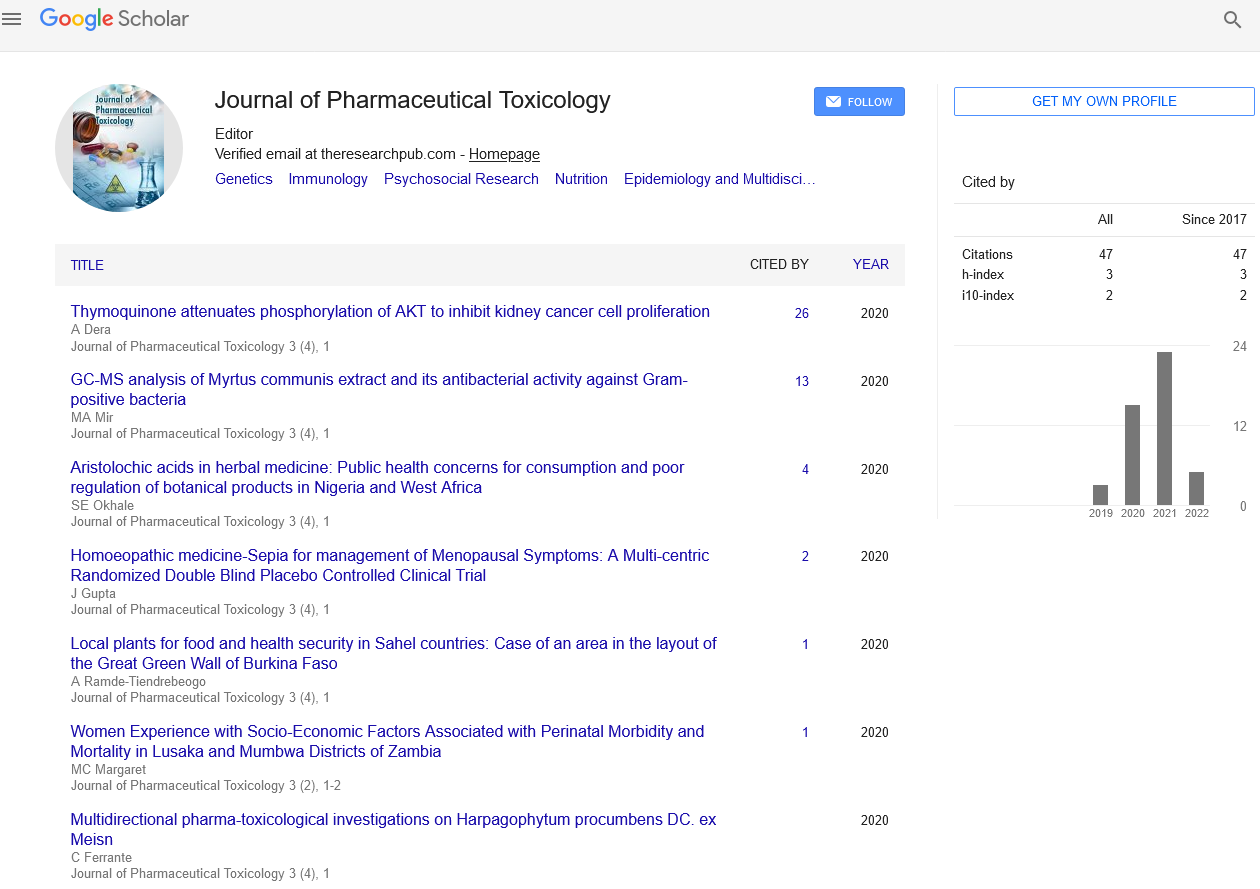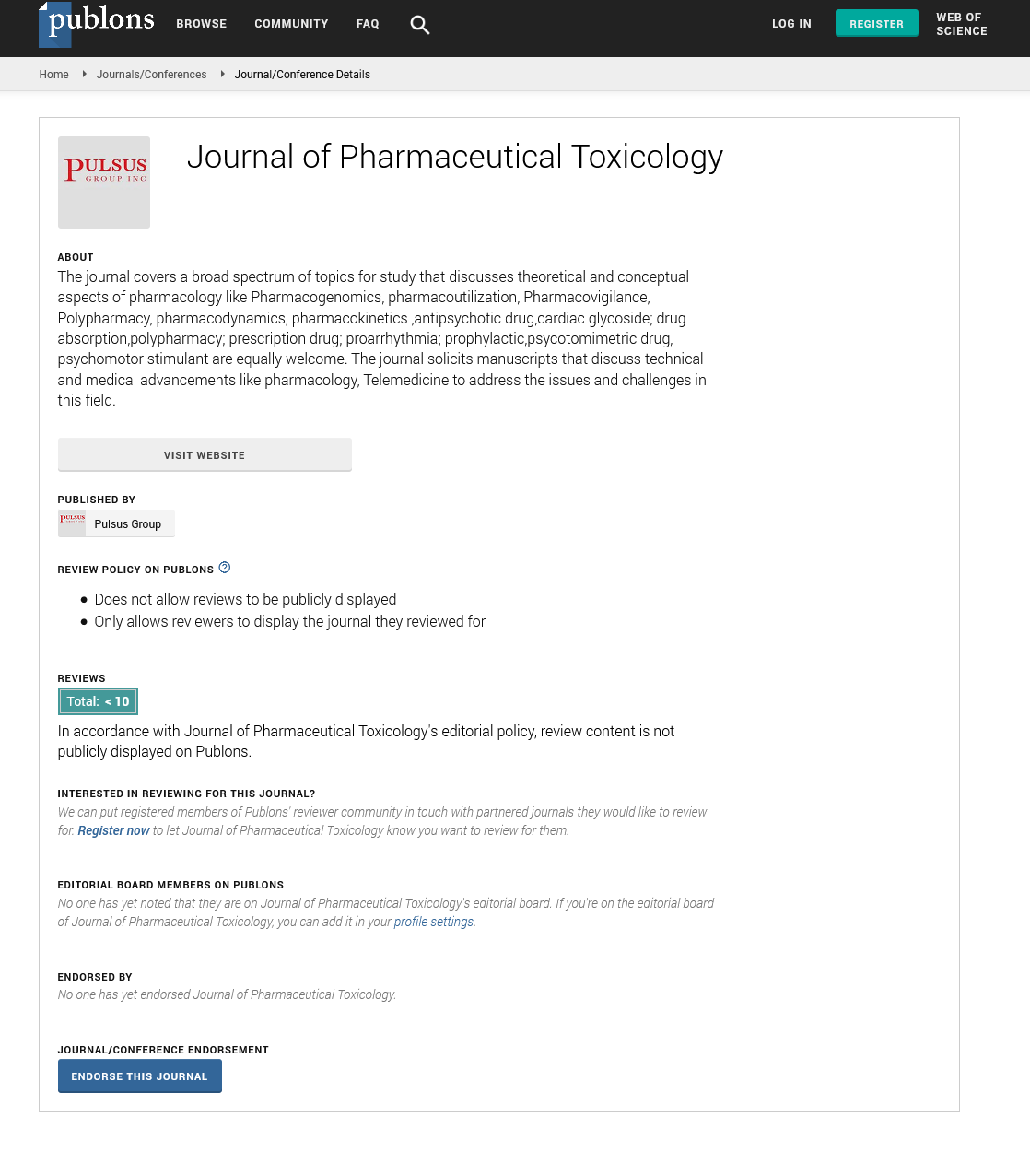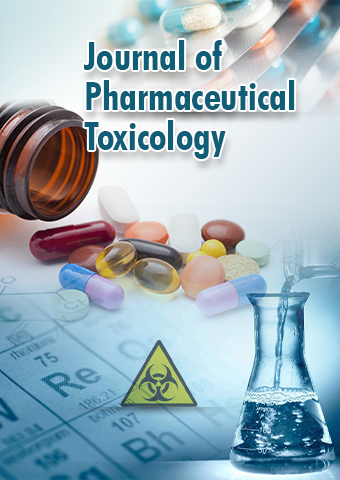Commentary - Journal of Pharmaceutical Toxicology (2023) Volume 6, Issue 3
Advancements in Precision Medicine: Transforming the Pharmaceutical Landscape
David Guaiac*
University of Cambridge, Cambridge, UK
- *Corresponding Author:
- David Guaiac
University of Cambridge, Cambridge, UK
E-mail: goiacdavid@rediff.com
Abstract
Keywords
Introduction
Precision medicine, a revolutionary approach to healthcare, is transforming the pharmaceutical industry by tailoring treatments to individual patients based on their unique genetic makeup, lifestyle, and environment. This personalized approach holds immense potential to improve patient outcomes, enhance drug efficacy, and reduce adverse effects. In this article, we will explore the key advancements in precision medicine and their impact on the pharmaceutical landscape. Advancements in genomics have significantly contributed to precision medicine. With the advent of next-generation sequencing technologies, researchers can now analyze an individual’s genetic information at an unprecedented level of detail. This enables the identification of genetic variations that may influence drug response, metabolism, and toxicity. Pharmacogenomics, a subset of precision medicine, aims to utilize this information to optimize drug selection and dosage for individual patients [1,2].
Biomarkers play a crucial role in precision medicine by providing measurable indicators of a patient’s health status or response to treatment. Pharmaceutical companies are actively investing in biomarker discovery research to identify reliable markers that can predict drug response, disease progression, or therapeutic efficacy. Additionally, the development of companion diagnostics, which are tests that identify specific biomarkers to guide treatment decisions, is gaining momentum. These diagnostics help physicians determine the most suitable treatment options for individual patients, increasing the likelihood of positive outcomes [3].
Material & Methods
The integration of artificial intelligence (AI) and machine learning (ML) algorithms is revolutionizing the pharmaceutical industry. These technologies can analyze vast amounts of patient data, including electronic health records, medical imaging, and genomic information, to identify patterns and generate actionable insights. AI-powered algorithms are assisting in drug discovery, predicting drug toxicity, optimizing clinical trial design, and enabling more personalized treatment regimens. The ability to analyze big data efficiently is unlocking new opportunities for targeted therapies and drug development.
Precision medicine is driving therapeutic advancements, particularly in the field of oncology. Targeted therapies, such as monoclonal antibodies and small molecule inhibitors, are designed to act on specific molecular targets in cancer cells, minimizing harm to healthy cells. These therapies are transforming the treatment landscape, improving survival rates, and reducing side effects compared to conventional chemotherapy. Furthermore, breakthroughs in gene and cell therapies, such as CAR-T cell therapy, are offering new avenues for treating genetic disorders and certain types of cancer.
Results
The rapid progress in precision medicine poses regulatory and ethical challenges that need to be addressed. Regulatory agencies are adapting their frameworks to accommodate personalized therapies and ensure their safety and efficacy. Additionally, protecting patient privacy, ensuring equitable access to precision medicine, and addressing concerns related to data security and informed consent are critical aspects that require attention.
Precision medicine is a game-changer in the pharmaceutical industry, offering the promise of more effective and personalized treatments. Advancements in genomics, biomarker discovery, AI and machine learning, and therapeutic innovations are revolutionizing drug development and patient care. However, addressing the associated regulatory and ethical considerations will be vital to fully realize the potential of precision medicine. With continued research and collaboration, precision medicine is poised to transform healthcare and improve patient outcomes in the years to come. Targeted drug delivery systems have emerged as a promising approach in pharmaceutical research and development, aiming to improve the therapeutic efficacy of drugs while minimizing their side effects. These systems utilize various strategies to selectively deliver drugs to specific cells, tissues, or organs, thereby increasing drug concentration at the desired site of action. This article explores recent advances in targeted drug delivery systems and their potential impact on improving patient outcomes.
Discussion
Nanotechnology has revolutionized the field of drug delivery by enabling the design and fabrication of nanoparticles with unique properties. These nanoparticles can be engineered to carry therapeutic agents, protect them from degradation, and target specific cells or tissues. Advances in nanoparticle-based drug delivery systems include the use of multifunctional nanoparticles, such as polymeric nanoparticles, liposomes, and Dendrimers, which can encapsulate a variety of drugs and exhibit controlled release profiles. Ligand-mediated targeting involves the attachment of specific ligands to drug delivery systems to enhance their affinity for target cells or tissues [4-7].
Ligands can be antibodies, peptides, aptamers, or small molecules that bind to receptors or markers overexpressed on the surface of diseased cells. This approach allows for precise drug delivery to the intended site, minimizing offtarget effects. Recent advancements in ligandmediated targeting include the development of novel ligands with higher binding affinity and improved stability.
Stimuli-responsive drug delivery systems are designed to release drugs in response to specific environmental cues, such as changes in pH, temperature, enzyme activity, or the presence of specific molecules. These systems can enhance drug accumulation at the target site while reducing drug release in healthy tissues. Recent developments in stimuli-responsive drug delivery systems involve the use of smart materials, such as hydrogels, micelles, and polymers, which can undergo reversible changes in response to external stimuli [8-10].
Conclusion
Advancements in personalized medicine have opened up new possibilities for targeted drug delivery. By considering individual patient characteristics, including genetics, biomarkers, and disease stage, tailored drug delivery systems can be developed to optimize treatment outcomes. Furthermore, Theranostics, a field combining therapy and diagnostics, allows for the simultaneous delivery of therapeutic agents and imaging probes, enabling real-time monitoring of treatment response. Recent advances in targeted drug delivery systems hold great promise for improving the efficacy and safety of pharmaceutical interventions. Nanoparticlebased systems, ligand-mediated targeting, stimuli-responsive systems, and personalized medicine approaches are paving the way for more precise drug delivery to diseased tissues. The continued progress in this field is expected to revolutionize the pharmaceutical industry, leading to enhanced therapeutic outcomes and improved patient care.
Acknowledgement
None
Conflict of Interest
None
References
- Van den Anker J, Reed MD, Allegaert K et al. Developmental Changes in Pharmacokinetics and Pharmacodynamics. J Clin Pharmacol. 58, 10-25 (2018).
- Aagaard L. Off-Label and Unlicensed Prescribing of Medicines in Paediatric Populations: Occurrence and Safety Aspects. Clin Pharmacol Toxicol. 117, 215–218(2015).
- Gore R, Chugh PK, Tripathi CD. Pediatric Off-Label and Unlicensed Drug Use and Its Implications. Curr. Clin. Pharmacol.12, 18–25 (2018).
- Sketris, IS. American Geriatrics Society Beers Criteria® Update Expert Panel. American Geriatrics Society 2019 Updated AGS Beers Criteria® for Potentially Inappropriate Medication Use in Older Adults. J Am Geriatr Soc. 67, 674–694 (2019).
- Hill-Taylor B, Walsh KA, Stewart S et al. Effectiveness of the STOPP/START (Screening Tool of Older Persons’ potentially inappropriate Prescriptions/Screening Tool to Alert doctors to the Right Treatment) criteria: Systematic review and meta-analysis of randomized controlled studies. J Clin Pharm Ther. 41, 158–169 (2016).
- Tommelein E, Mehuys E, Petrovic M et al. Potentially inappropriate prescribing in community-dwelling older people across Europe: A systematic literature review. Eur J Clin Pharmacol. 71, 1415–1427.
- Prot-Labarthe S, Weil T, Angoulvant F et al. POPI (Pediatrics: Omission of Prescriptions and Inappropriate prescriptions): Development of a tool to identify inappropriate prescribing. PLoS ONE. 9,25-68.
- Corrick F, Conroy S, Sammons H et al. Paediatric Rational Prescribing: A Systematic Review of Assessment Tools. Int J Environ Res Public Health. 17, 1473-1496 (2015).
- Sadozai L, Sable S, Le E Roux et al. International consensus validation of the POPI tool (Pediatrics: Omission of Prescriptions and Inappropriate prescriptions) to identify inappropriate prescribing in pediatrics. PLoS ONE .15, 47-72 (2018).
- Barry E, Moriarty F, Boland F et al. The PIPc Study-application of indicators of potentially inappropriate prescribing in children (PIPc) to a national prescribing database in Ireland: A cross-sectional prevalence study. BMJ Open. 8, 69-556 (2019).
Indexed at, Google Scholar, Cross ref
Indexed at, Google Scholar, Cross ref
Indexed at, Google Scholar, Cross ref
Indexed at, Google Scholar, Cross ref
Indexed at, Google Scholar, Cross ref
Indexed at, Google Scholar, Cross ref


